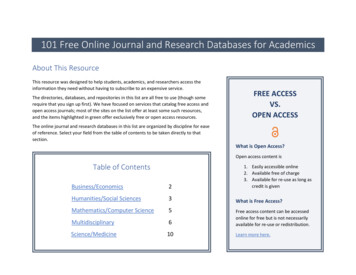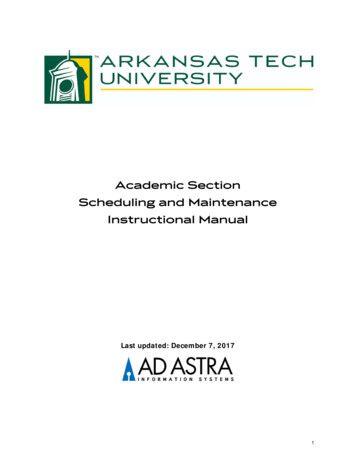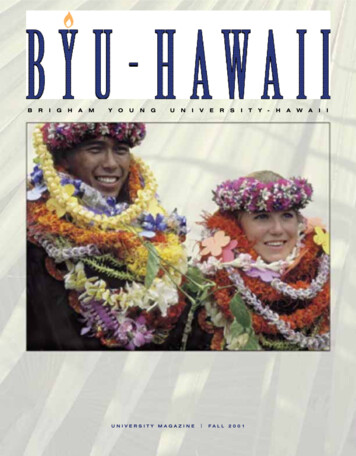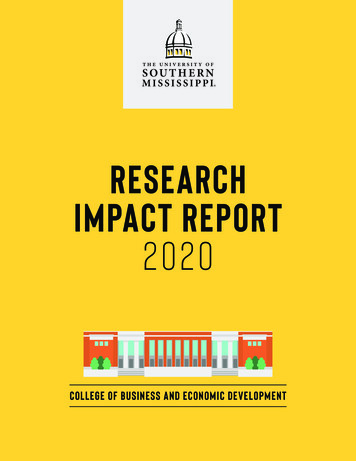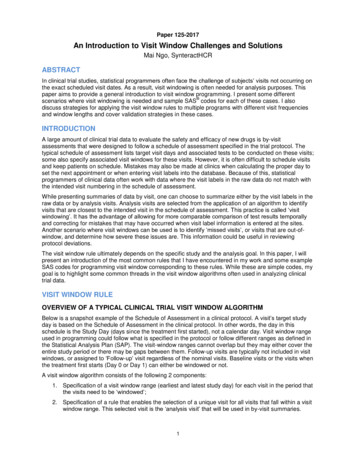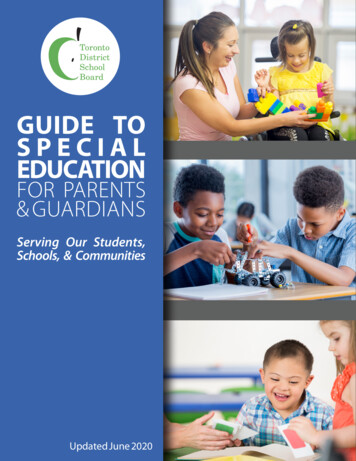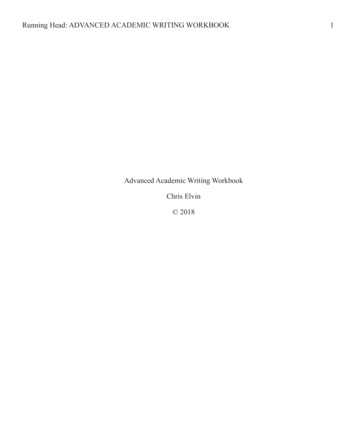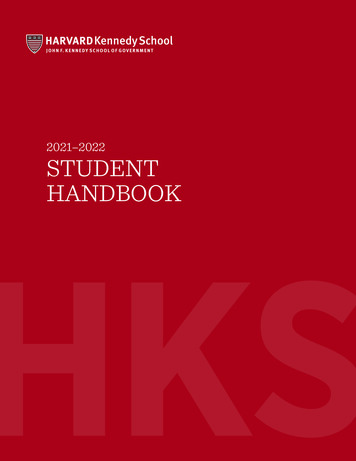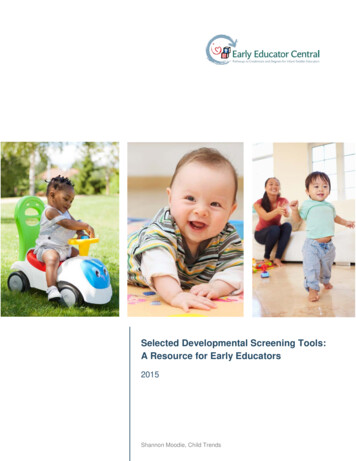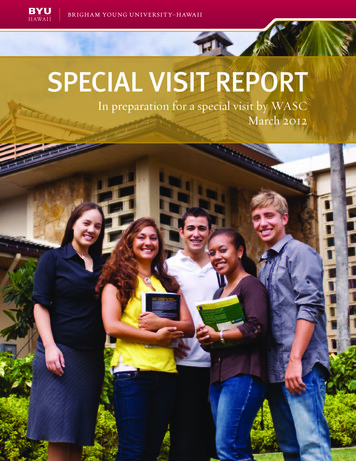
Transcription
BR IGH AM OUNG UNIV ER SIT –H AWAIISPECIAL VISIT REPORTIn preparation for a special visit by WASCMarch 2012
BR IGH AM OUNG UNIV ER SIT –H AWAIISPECIAL VISIT REPORTIn preparation for a special visit by WASCMarch 2012
brigham \oung universit\–hawaiiI. Introduction1II. Nature of the Institution and Major Changes Since the Last WASC Visit1Initiatives Designed to Improve the Quality of Teaching and Learning. 3Academic Colleges and Administrative Duties Reorganized. 3University’s Vision and Mission Statements Refined. 3BYU–Hawaii Framework for Student Learning. 4Reducing Faculty Turnover. . 5International Student Readiness Improved. 5Faculty Professional Development Emphasized. 6Improving Career and Employment Prospects for Graduating Students. 6Upgrading of Technology Support and Physical Facilities. 6Initiatives Designed to Decrease Costs. 6Instilling a Culture of Stewardship and Cost Control. 6Online Learning. 7Initiatives Designed to Increase the Number of Students Served. 8Change in the Academic Calendar and the Nine Semester “Allotment of Semesters” Plan. 8Augmented Faculty Contracts. 8Efforts to Increase the Size of the University. 9III. Report PreparationIV. Issues Identified by the WASC Commission910Balancing Financial Priorities with Providing a Strong Educational Experience, Especially forUnderserved and Financially Limited Students. 10Tuition Rates. 11Student to Faculty Ratio. 11Impact of the New Calendar on Students and Faculty. 11International Students and the IWORK Program.12iLead Certificate Program. 13Tutoring Services. 13Efforts of Faculty and Career Services to Increase Student Marketability. 13Assessment of Learning. 15Key Decisions Made To Strengthen Assessment. 15Assessment in Three Academic Departments–A Continuum of Development. 16Assessment in the Department of Residential Life. 18Program Review Process. 18Sustaining Assessment in the Future. 19Faculty Scholarship and Faculty Life. 19Influence on Faculty Satisfaction and Productivity. 19Response on Communication and Balancing Teaching and Professional Development.20Faculty Members’ Current Engagement in Professional Development.20Increased Transparency in Continuing Faculty Status and Promotion Criteria. 21Faculty Turnover and Ability to Hire Outstanding New Faculty. 21Faculty Housing Needs.22V. Other Issues Facing the University and Changes That Are Currently Being Considered22Rethinking General Education. 22Planning Growth of the University. 22VI. Summary23
Appendices25Appendix AAppendix BAppendix CAppendix DAppendix EAppendix FAppendix GAppendix HAppendix IAppendix JAppendix KAppendix LData Exhibits. 26Enrollment Data. 34The BYU–Hawaii Framework for Student Learning. 36Distance Learning for International Students Learning English. 39Tuition Rates. 41Distance Learning and Online Course Data. 42Academic Calendars. 44Evaluating the Effectiveness of the New Academic Calendar. 46Program Review Process. 50BYU–Hawaii Faculty and Administration Communication Plan. 54Faculty Professional Development Policy. 55Continuing Faculty Status and Rank Advancement Expectations for Faculty Members atBrigham Young University–Hawaii. 56TablesTable 1Table 2Table 3Table 4Table 5Table 6Percent of University’s Operating Budget Covered by LDS Church . 7Number of Applications to BYU–Hawaii, 2008–2011.10FTE Student to Faculty Ratios .11Total Bachelor’s Degrees Awarded at BYU–Hawaii by Area. 13Percent of Total Bachelor’s Degrees Awarded by Area. 13Number of Student Internships by Year.14
I. IntroductionOn June 30, 2008, Ralph A. Wolff, President andExecutive Director of the WASC Accrediting Commission for Senior Colleges and Universities (theCommission), informed President Steven C. Wheelwright, President of Brigham Young University–Hawaii (BYU–Hawaii), of the Commission’s decision toreaffirm BYU–Hawaii’s accreditation. The Commission praised BYU–Hawaii for “continuing itshistory of providing solid educational programs fora very diverse student population and for preparing students well to return to their home countrieswith employable skills and a vision for making adifference in their world.” The Commission gaveparticular praise for BYU–Hawaii’s assessmente-portfolio, the General Education Committee’swork in identifying and assessing core qualities of agenerally educated person, and the cross-disciplinework of the University Assessment Committee indesigning and implementing program reviews.Because the university was in transition with a newPresident, Vice President of Academics and VicePresident of Student Life, the Commission expressed some concerns and requested a Special Visitin Spring 2012 to evaluate progress on three primaryissues, discussed in Section IV in more detail.A. Balancing Financial Priorities with Providinga Strong Educational Experience, Especiallyfor Underserved and Financially Limited Students. The Commission was concerned abouthow the effort to decrease costs per student andincrease the number of students served wouldimpact key aspects of BYU–Hawaii’s institutional mission to provide a quality education tostudents, especially those from the Asia Pacificarea.B. Assessment of Learning. Based on reportsfrom the WASC visiting team, the Commissionwas concerned that BYU–Hawaii’s ambitiouscommitment to integrate assessment into itsacademic culture might be losing focus andmomentum.C. Faculty Scholarship and Faculty Life. TheCommission was concerned that the apparent shift in emphasis from additional classicalresearch back to an increased emphasis onteaching and teaching loads for some might putfaculty scholarship at risk, and wondered howpossible perceived ambiguity about the roleof scholarship would affect faculty retention,development and promotion.This report begins with a description of BYU–Hawaii and its mission and strategy and an overviewof major initiatives and changes that have beenpursued since WASC’s last visit in March 2008. Thisis followed by a brief statement on report preparation. The bulk of the report then responds to thethree issues identified by the Commission andthe last visiting team. The report concludes with adescription of other opportunities and issues facingthe university, the changes that are currently beingconsidered to address those, and then a final summary statement.II. Nature of the Institution and MajorChanges Since the Last WASC VisitBYU–Hawaii is owned and operated by the Churchof Jesus Christ of Latter-day Saints (LDS Church).The LDS Church also owns and operates BYU–Idaho and BYU Provo, which have much larger, albeitmainly North American enrollments. All threeinstitutions share the same Board. A faith-basedinstitution, BYU–Hawaii’s mission is “to integrateboth spiritual and secular learning, and to preparestudents with character and integrity who can provide leadership in their families, their communities,their chosen fields, and in building the kingdom ofGod.”Originally focused on providing academic andvocational training to students from Hawaii andthe greater Pacific, BYU–Hawaii now serves 2784undergraduate students from 78 countries. (Withinthe LDS Church, both BYU–Idaho and BYU–Hawaiionly offer undergraduate education, while BYUProvo offers a wide range of graduate programs aswell.) In Winter 2012, 49.5 percent of those studentswere from the primary Asia-Pacific area (includingHawaii). 42.6 percent of the students were international, with 37.8 percent from the university’sinternational target area (see Appendix B for moredetail about enrollment data). The university’s goalis to have 50% of the students from the international target area, another 15% from Hawaii and thebalance from the U.S. mainland and other international countries.One of the challenges BYU–Hawaii faces is making sure that incoming international students areprepared both academically and in terms of Englishso they can successfully complete their bachelor’sdegree. BYU–Hawaii has implemented a numberof innovative programs to meet these challenges.It has long had a strong EIL (English as an International Language) program to help international1
brigham \oung universit\–hawaiistudents improve their English skills. To improveacademic readiness, several hundred internationalstudents can now take English and general education courses online before they enroll at BYU–Hawaii. A program known as IWORK providesfinancial aid for about half of the internationalstudents and the majority of the students work upto 19 hours per week at BYU–Hawaii or its sisterinstitution, the Polynesian Cultural Center. TheInternational Student Office provides help with immigration and other international student concerns,and a number of tutoring offices assist studentsneeding additional academic help.While challenging, the diverse international student body provides unique opportunities for allstudents to study, work, socialize, and learn fromstudents from all over the world. There are currently 22 country-based culture clubs on campus,ranging from the African Club to the Tongan Club.Students also actively participate in such highlyanticipated events as Food Fest and Culture Night.BYU–Hawaii is an NCAA Division II participant in11 sports. Since moving to Division II, BYU–Hawaiihas won 7 national championships in women’stennis, two in men’s tennis and one in women’svolleyball. Last year our men’s basketball teamadvanced to the national championship game withteam members drawn from five different countries.When WASC last visited BYU–Hawaii in March2008, university leadership was in a state of transition. President Wheelwright began his service inJune 2007. Max Checketts, formerly the VP of Academics at BYU–Idaho, arrived as BYU–Hawaii VPof Academics in April 2008 and Debbie HippoliteWright a former faculty member and DepartmentHead at BYU–Hawaii returned to the university inJuly of 2008 as VP of Student Life and Student Services. When President Wheelwright was appointed,the university’s Board of Directors gave him amandate to continue to improve the quality of theBYU–Hawaii currently offers 25 majors, served by courses offered in the following colleges and departments.CollegeBusiness, Computing and GovernmentHuman DevelopmentLanguage, Culture and ArtsMath and SciencesDepartmentsAccountingBusiness ManagementComputer and Information SciencesPolitical ScienceEducationEnglish Language Teaching and LearningReligious EducationSocial WorkEnglishFine ArtsHistoryInternational Cultural StudiesHawaiian and Pacific Island StudiesBiologyBiochemistryExercise and Sports ScienceMathematicsPsychologyBYU–Hawaii is led by a President’s Council comprised of the following:PresidentSteven C. WheelwrightVice President of AcademicsMax L. CheckettsVice President for Administrative ServicesMichael B. BlissVice President for Student Development and ServicesDebbie Hippolite WrightVice President for Construction and Facilities Management David Lewis2
educational experience, to decrease costs to boththe LDS Church and to students and their families,and to increase the number of students served.These became known as the “three imperatives”that BYU–Hawaii needed to address.While a daunting challenge, in retrospect BYU–Hawaii’s Board was clearly ahead of its time. In thefour years since WASC’s last visit, nearly all universities in the country have faced a similar mandate:improve the quality of teaching and learning sothat students are better prepared for an increasingly challenging and competitive workplace, whilefacing the economic realities of declining budgets.In the case of BYU–Hawaii, this has not alteredthe mission, but has required the development ofa strategy and a set of initiatives that would moreeffectively and efficiently deliver on that mission.In its efforts to meet the Board’s mandates and aspart of its strategic plan, BYU–Hawaii has implemented a number of initiatives, and is consideringothers. These initiatives can be grouped into (1)those designed to continue to improve the qualityof teaching and learning experiences on campus,(2) those designed to lower the cost of a BYU–Hawaii education both to the student and their familyand to the LDS Church and (3) those designed toincrease the number of students served.Initiatives Designed to Continue to Improve theQuality of Teaching and LearningIn order to ensure that students will be appropriately prepared to return to their home region topursue successful lives and careers, BYU–Hawaiihas been asked by its Board to seek ways to continually improve the quality of all aspects of theeducational experience of its students. A numberof specific initiatives have been undertaken inthe past four plus years in order to deliver on thisimperative. Collectively, these initiatives along witha number of other ongoing efforts, constitute theuniversity’s strategy for addressing this imperative. The most important of these initiatives aredescribed below.1. Academic Colleges and Administrative Duties Reorganized. Since WASC’s last visit, the university’sacademic departments have been reorganized.Before the change, the College of Arts and Sciences managed approximately 75% of the faculty.The other 25% of the faculty were divided betweenthree professional schools—the Schools of Business, Education and Computing—each with its owndean. The reorganization created four colleges ofroughly equal size: (1) Business, Computing andGovernment, (2) Human Development, (3) Language, Culture and Arts and (4) Math and Sciences.This reorganization has provided several benefits.The first was to balance the workload of deans. Thesecond was to bring college leadership and supportservices closer to the students than was previouslypossible in the former College of Arts and Sciences.A third was to organize faculty into more homogeneous groups who share similar interests, goals andcore academic disciplines, as well as approachesto teaching, research and career planning anddevelopment.This reorganization into four colleges also strengthened leadership at the college level and facilitatedthe creation of a Deans Council which meets withthe Academic Vice President and other key serviceproviders supporting academics to address issuesand opportunities that merit attention. In addition,the position of Associate Academic Vice President(AAVP) was created. There are currently threeAAVPs who meet periodically with the Dean’sCouncil. These AAVPs are teaching faculty withone focused on instruction and learning, a secondfocused on curriculum, registration and advising,and a third focused on institutional research andeffectiveness. Each of these AAVPs is responsiblefor one or two of the primary initiatives beingundertaken to continue to improve the quality ofeducation.2. University’s Vision and Mission StatementsRefined. Sponsored by the Church of Jesus Christof Latter-day Saints, BYU–Hawaii has always had aunique vision and mission. A committee comprisedof faculty, staff and administrators has worked torefine and simplify the vision and mission. Thoseare now stated as:Vision. Brigham Young University–Hawaii,founded by prophets and operated by The Churchof Jesus Christ of Latter-day Saints, exists to assistindividuals in their quest for perfection and eternallife and in their efforts to influence the establishment of peace internationally.Mission. The mission of Brigham Young University–Hawaii is to integrate both spiritual and secularlearning, and to prepare students with characterand integrity who can provide leadership in theirfamilies, their communities, their chosen fields, andin building the kingdom of God.3
brigham \oung universit\–hawaiiStated even more succinctly, the mission of BYU–Hawaii is to prepare students to be learners, leadersand builders. We want each student who attendsBYU–Hawaii to: Learn Integrate spiritual and secular learning toprovide them with a foundation for a lifetime oflearning. Lead Assist young men and young women indeveloping character and integrity so they canprovide leadership in all aspects of their lives. Build Provide a significant group of faithfuland committed church leaders who will assist inbuilding the kingdom, particularly in the Pacificand Asia.This triad is at the heart of the university’s strategicplan and is the basis of many of the initiatives takensince WASC’s last visit.3. BYU–Hawaii Framework for Student Learning. Focused on the mandate to improve student learning,BYU–Hawaii began a multi-year project in 2009 toidentify major obstacles to student learning andthen design a framework to guide needed improvements. The project was led by a faculty and studentsteering committee who spent approximately oneyear reviewing the literature on teaching andlearning; interviewing faculty, administrators,students and alumni; and conducting focus groupswith 65 of 128 faculty and approximately 130students.A major finding of this project, and one that isconsistent with Arum and Roksa’s analysis in thewidely acclaimed Academically Adrift (Arum andRoksa, 2011), is that improvements in student learning require significant changes to the culture oflearning at BYU–Hawaii. Most notable, especiallyin the student focus groups, is the finding thatstudents spend disturbingly little time preparingfor class, making them ill-prepared to effectivelyengage in learning while in class.This and other findings led the steering committee to draft a document titled “The BYU–HawaiiFramework for Student Learning” (the Framework—see Appendix C) which subsequently hasbeen extensively reviewed and refined by facultyand students across the campus. The Frameworkcenters on three key practices: Prepare, Engage andImprove. Accompanying these are six principles: (1)motivated by faith, guided by the spirit, centered4on serving God; (2) active involvement in the learning process; (3) self-directed, taking responsibilityfor learning; (4) engaged in meaningful reflectionand self-assessment; (5) open to changing how tothink, feel and act; and (6) constantly improving thecapacity to study and learn effectively.To institutionalize the Framework for StudentLearning, BYU–Hawaii has thus far: Redesigned the orientations for new studentsand new faculty Provided new professional development moneyto support faculty seeking experience with innovative learning strategies Initiated a university-wide address by the president on the topic Sponsored faculty seminars and symposia on theFramework for Student Learning Sponsored a series of seminars involving thePresident and other faculty in training over 130student leaders on the Framework and its meritsand inviting them to support and reinforce theFramework both personally and in their studentleader positions Provided support materials for faculty, studentsand prospective students Developed a process to facilitate faculty visiting one another’s classes in order to share ideasand provide peer feedback. During the past sixmonths all of the faculty hired in the past fiveyears have had at least one such visit. Directed deans to devote a portion of their annual faculty reviews to plans on how to incorporate the Framework in teaching and assessment. Made this Framework and its implementation theprimary responsiblity of an Associate AcademicVice President. Coordinated with staff and support services toensure that the Framework’s principles and practices are incorporated into student activities andstudent employment. Begun developing a multimedia website for innovations in teaching and learning
While the processes of implementation and roll-outof these principles and practices are well underway,this is an ongoing effort requiring additional yearsto gain the full benefits that this Framework offers.4. Reducing Faculty Turnover. Recognizing thatfaculty turnover was historically a significanthindrance to quality teaching, and that the costof housing in Hawaii was contributing to excessive turnover, a number of actions were taken toprovide faculty with additional options concerningtheir housing. A Mortgage Assistance Program (MAP) wasdeveloped with Board approval so that facultydesiring to buy their own home within drivingdistance of the campus could receive a 30,000benefit to assist in doing so. One-third of thisbenefit comes in the form of assistance with thedown payment, one-third as assistance withclosing costs and one-third as assistance withmonthly payments during the first five years.Thus far, ten faculty and senior staff have takenadvantage of this program. The university sought and received approvalfrom the Board and also from the City of Honolulu to sell as leasehold properties its on-campustownhouses to faculty. The faculty memberpurchases the home, but not the land, thus reducing the cost to about half of what the same homewith its land included would have cost. Thisallows many faculty members to contemplatehome ownership with most of its benefits, at a farmore affordable price. To date eight faculty haveavailed themselves of this option. Most recently the university added a rent subsidy program whereby faculty members couldreceive a monthly housing allowance towards arental of their choice for up to five years if theychose to live in non-university owned housing.This allows faculty greater flexibility to choosetheir community and housing, and eventuallytake advantage of one of the other programs topurchase their own home. Thus far two facultymembers have taken advantage of this program.In addition to these programs, BYU–Hawaii hasstarted to replace homes that have reached the endof their useful life. Newly constructed three- andfour-bedroom homes are being built in a duplexstyle and have been very well received. The university continues to look at other options in order toprovide the mix of housing types that will matchfaculty needs and preferences going forward inthe future. All of these efforts together have givenfaculty more options, thus reducing the turnover infaculty and thereby improving the quality, continuity, and sustainability of excellent teaching.5. International Student Readiness Improved. Sinceits inception, BYU–Hawaii has known that international students from less developed areas of Asiaand the Pacific have faced significant challenges ingaining sufficient English language skills and foundational academic preparation to succeed in theircourse work at BYU–Hawaii. Over the past fiveyears, the university has pursued a range of initiatives to assist these students prior to their arrival oncampus. Three of these intiatives have contributedsignificantly to improved grade performance andcourse completion rates for these students. Standards for both English ability and academicaccomplishment have been raised and clearlystated. These have been communicated extensively to prospective students and options have beenprovided for how students close to the requiredstandards might further improve their readinessto meet those standards. In addition, personalreferences from leaders who have supervisedmany of these prospective students during theirtwo years of missionary service have been addedas a valuable source of information regardingstudy and work habits and self-discipline. Thesenew standards have resulted in fewer academicproblems and more consistent progress towardgraduation. To improve academic and English language readiness of applicants, BYU–Hawaii has developeda set of over 50 online courses in EIL (English asan International Language) and General Education over the past three years. Over 700 studentsin 70 countries are currently enrolled in thesecourses. Illustrative of the progress being made,from Winter 2010 through Spring 2011, a total of396 students enrolled in online EIL courses withcompletion rates ranging from 95% to 100% (seeAppendix D). Growing numbers of these onlinestudents are now qualifying for admissions toBYU–Hawaii. For many years, a major source of Polynesianstudents for BYU–Hawaii has been the six highschools operated by the LDS Church in Tonga,Samoa, Fiji and Kiribati. During recent years theuniversity has strengthened its teacher preparation program resulting in growing numbers of5
brigham \oung universit\–hawaiicollege-trained teachers for these high schools.In addition, by the end of 2012 BYU–Hawaii willbe offering its online courses in all six of thesehigh schools as their “honors” program. Studentswho successfully complete courses earn creditstowards both high school graduation and university graduation.6. Faculty Professional Development Emphasized.The mandate to improve teaching and learningincluded an emphasis on professional developmentthat will keep faculty current in their fields. BYU–Hawaii set a goal to have 10% of the course loadcontracted for use in faculty administration anddevelopment. The development portion can be usedfor research in the faculty member’s chosen field,course development, teaching innovation, or otherprofessional development. Each year the availabletime is allocated by department chairs and deansbased on the project proposals submitted by theirfaculty. The re
the greater Pacific, BYU-Hawaii now serves 2784 undergraduate students from 78 countries. (Within the LDS Church, both BYU-Idaho and BYU-Hawaii only offer undergraduate education, while BYU Provo offers a wide range of graduate programs as well.) In Winter 2012, 49.5 percent of those students were from the primary Asia-Pacific area (including
